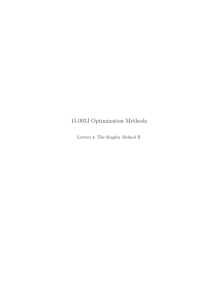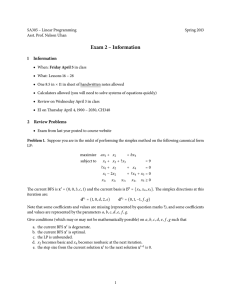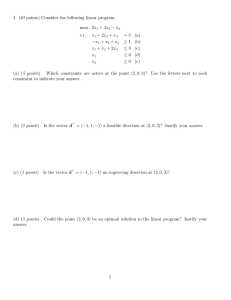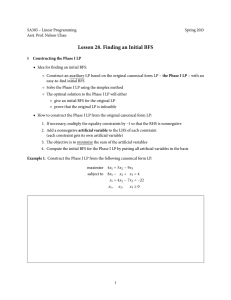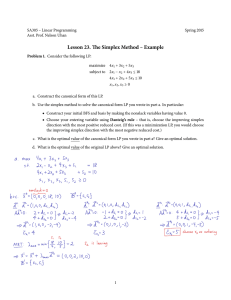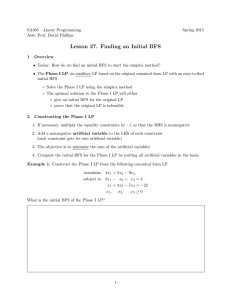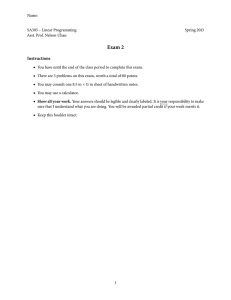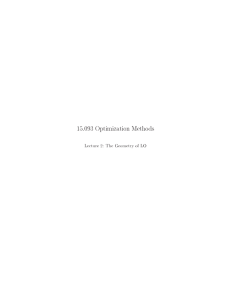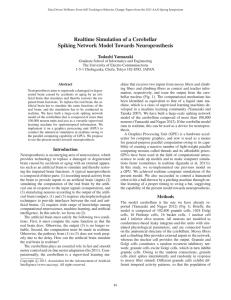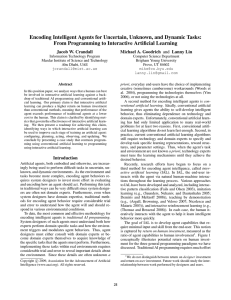15.081J/6.251J Introduction to Mathematical Programming Lecture 7: The Simplex Method III
advertisement
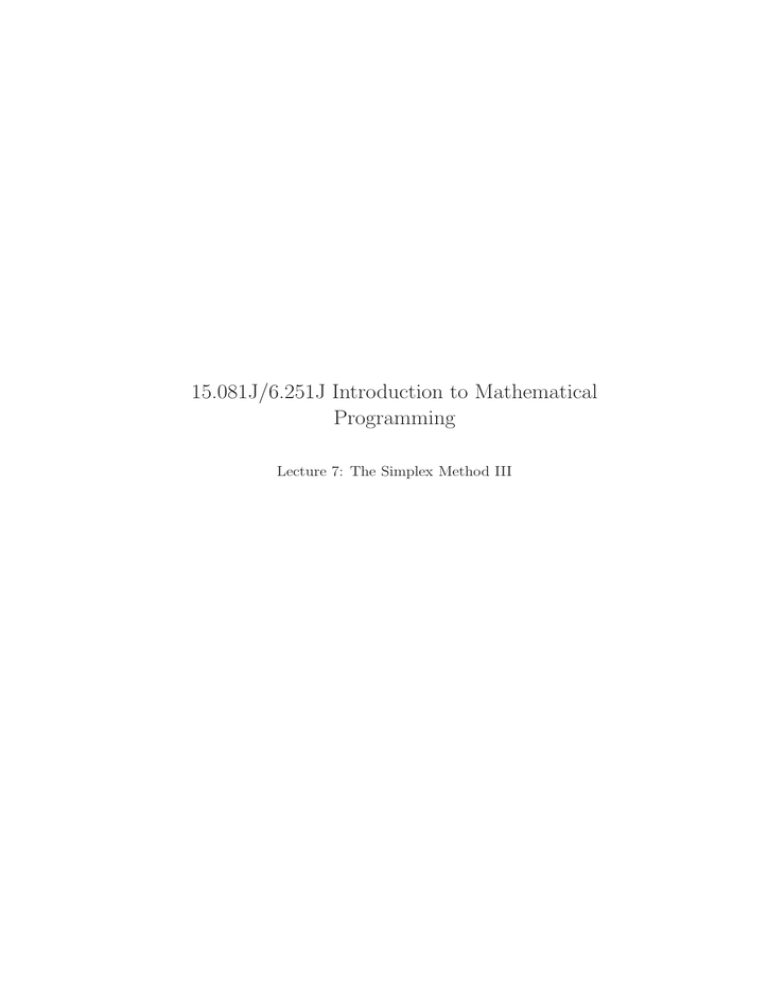
15.081J/6.251J Introduction to Mathematical Programming Lecture 7: The Simplex Method III 1 Outline Slide 1 • Finding an initial BFS • The complete algorithm • The column geometry • Computational efficiency • The diameter of polyhedra and the Hirch conjecture 2 Finding an initial BFS Slide 2 • Goal: Obtain a BFS of Ax = b, or decide that LOP is infeasible. x ≥ 0 • Special case: b ≥ 0 Ax ≤ b, x ≥ 0 ⇒ Ax + s = b, s = b, 2.1 x, s ≥ 0 x=0 Artificial variables Slide 3 Ax = b, x≥0 1. Multiply rows with −1 to get b ≥ 0. 2. Introduce artificial variables y, start with initial BFS y = b, x = 0, and apply simplex to auxiliary problem min y1 + y2 + . . . + ym s.t. Ax + y = b x, y ≥ 0 Slide 4 3. If cost > 0 ⇒ LOP infeasible; stop. 4. If cost = 0 and no artificial variable is in the basis, then a BFS was found. 5. Else, all yi∗ = 0, but some are still in the basis. Say we have AB(1) , . . . , AB(k) in basis k < m. There are m − k additional columns of A to form a basis. Slide 5 6. Drive artificial variables out of the basis: If lth basic variable is artifi­ cial examine lth row of B −1 A. If all elements = 0 ⇒ row redundant. Otherwise pivot with = � 0 element. 1 2.2 Example Slide 6 min s.t. min s.t. x1 + x2 x1 + 2x2 −x1 + 2x2 4x2 + x3 + 3x3 + 6x3 + 9x3 3x3 + x4 x1 , . . . , x4 ≥ 0. = = = = 3 2 5 1 x5 + x6 + x7 + x8 x1 + 2x2 + 3x3 + x5 −x1 + 2x2 + 6x3 + x6 4x2 + 9x3 + x7 3x3 + x4 + x8 x1 , . . . , x8 ≥ 0. x1 −11 x2 x3 = = = = 3 2 5 1 Slide 7 x4 x5 x6 x7 x8 0 −8 −21 −1 0 0 0 0 x5 = 3 1 2 3 0 1 0 0 0 x6 = 2 −1 2 6 0 0 1 0 0 x7 = 5 0 4 9 0 0 0 1 0 x8 = 1 0 0 3 1* 0 0 0 1 x1 x2 x3 x4 x5 x6 x7 x8 −8 −18 0 0 0 0 1 −10 0 x5 = 3 1 2 3 0 1 0 0 0 x6 = 2 −1 2 6 0 0 1 0 0 x7 = 5 0 4 9 0 0 0 1 0 x4 = 1 0 0 3* 1 0 0 0 1 Slide 8 x1 x2 x3 x4 x5 x6 x7 x8 −4 0 −8 0 6 0 0 0 7 x5 = 2 1 2 0 −1 1 0 0 −1 x6 = 0 −1 2* 0 −2 0 1 0 −2 x7 = 2 0 4 0 −3 0 0 1 −3 x3 = 1/3 0 0 1 1/3 0 0 0 1/3 2 −4 x1 x2 x3 x4 x5 x6 x7 x8 −4 0 0 −2 0 4 0 −1 0 0 1 1 −1 0 1 0 1/2 0 −1 x5 = 2 2* x2 = 0 −1/2 1 0 −1 x7 = 2 2 0 0 1 0 −2 1 1 x3 = 1/3 0 0 1 1/3 0 0 0 1/3 Slide 9 x1 x2 x3 x4 x5 x6 x7 x8 0 0 0 0 0 2 2 0 1 x1 = 1 1 0 0 1/2 1/2 −1/2 0 1/2 x2 = 1/2 0 1 0 −3/4 1/4 1/4 0 −3/4 x7 = 0 0 0 0 0 −1 −1 1 0 x3 = 1/3 0 0 1 1/3 0 0 0 1/3 Slide 10 3 x1 x2 x3 x4 ∗ ∗ ∗ ∗ ∗ x1 = 1 1 0 0 1/2 x2 = 1/2 0 1 0 −3/4 x3 = 1/3 0 0 1 1/3 A complete Algorithm for LO Slide 11 Phase I: 1. By multiplying some of the constraints by −1, change the problem so that b ≥ 0. �m 2. Introduce y1 , . . . , ym , if necessary, and apply the simplex method to min i=1 yi . 3. If cost> 0, original problem is infeasible; STOP. 4. If cost= 0, a feasible solution to the original problem has been found. 5. Drive artificial variables out of the basis, potentially eliminating redundant rows. Phase II: 3 Slide 12 1. Let the final basis and tableau obtained from Phase I be the initial basis and tableau for Phase II. 2. Compute the reduced costs of all variables for this initial basis, using the cost coefficients of the original problem. 3. Apply the simplex method to the original problem. 3.1 Possible outcomes Slide 13 1. Infeasible: Detected at Phase I. 2. A has linearly dependent rows: Detected at Phase I, eliminate redundant rows. 3. Unbounded (cost= −∞): detected at Phase II. 4. Optimal solution: Terminate at Phase II in optimality check. 4 The big-M method min n � cj xj + M 5 Slide 14 yi i=1 j=1 s.t. m � Ax + y = b x, y ≥ 0 The Column Geometry Slide 15 min c′ x s.t. Ax = b e′ x = 1 x ≥ 0 � � � � � � � � A2 An b A1 = + · · · + xn x1 + x2 cn z c1 c2 6 Slide 16 Slide 17 Computational efficiency Slide 18 Exceptional practical behavior: linear in n Worst case max xn s.t. ǫ ≤ x1 ≤ 1 ǫxi−1 ≤ xi ≤ 1 − ǫxi−1 , i = 2, . . . , n Slide 19 Slide 20 Theorem 4 z B . . . I H F G C D E b . initialbasis . z . . 3 4 6 . . . . . . 2 1 7 nextbasis 8 5 optimalbasis b x3 x2 x2 x1 x1 (b) (a) 5 • The feasible set has 2n vertices • The vertices can be ordered so that each one is adjacent to and has lower cost than the previous one. • There exists a pivoting rule under which the simplex method requires 2n − 1 changes of basis before it terminates. 7 The Diameter of polyhedra Slide 21 • Given a polyhedron P , and x, y vertices of P , the distance d(x, y) is the minimum number of jumps from one vertex to an adjacent one to reach y starting from x. • The diameter D(P ) is the maximum of d(x, y) ∀x, y. Slide 22 • Δ(n, m) as the maximum of D(P ) over all bounded polyhedra in ℜn that are represented in terms of m inequality constraints. • Δu (n, m) is like Δ(n, m) but for possibly unbounded polyhedra. 7.1 The Hirsch Conjecture • Δ(2, m) = . . �m� 2 . Slide 23 , Δu (2, m) = m − 2 . . . . . . . . . . . . (b) (a) • Hirsch Conjecture: Δ(n, m) ≤ m − n. Slide 24 • We know that Δu (n, m) ≥ m − n + �n� 5 Δ(n, m) ≤ Δu (n, m) < m1+log2 n = (2n)log2 m 6 MIT OpenCourseWare http://ocw.mit.edu 6.251J / 15.081J Introduction to Mathematical Programming Fall 2009 For information about citing these materials or our Terms of Use, visit: http://ocw.mit.edu/terms.
